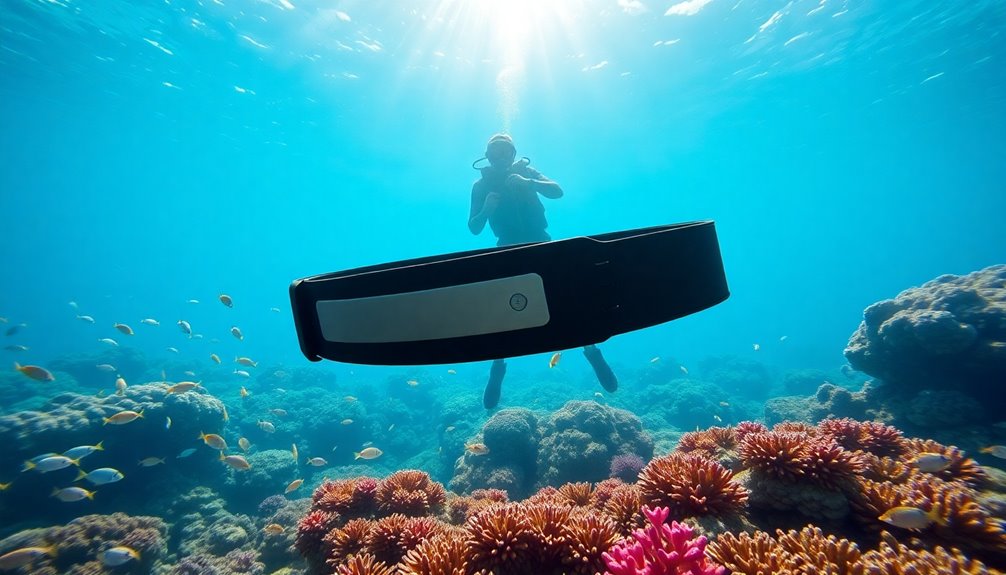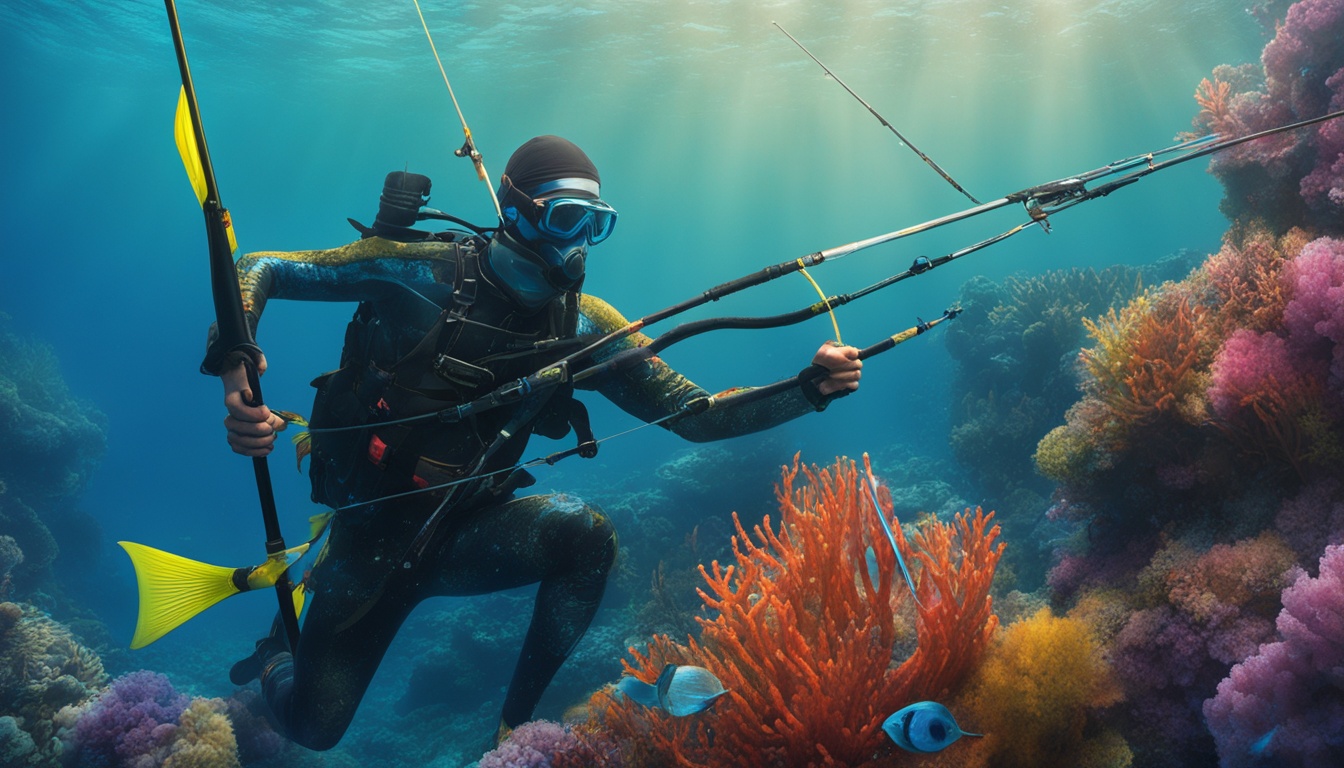A diving belt makes weight management effortless, enhancing your underwater experience. With adjustable fits and durable materials, these belts cater to divers of all sizes and skill levels. They help you achieve neutral buoyancy, allowing for smooth descents without exerting extra energy. Plus, the weight pockets let you easily adjust based on varying dive conditions, ensuring you're always prepared. High customer satisfaction ratings reflect their effectiveness and comfort in the water. To fully appreciate the benefits and tips for using your diving belt, there's much more to uncover about optimizing your dive experience!
Key Takeaways
- Adjustable nylon belts provide a customizable fit, ensuring secure and comfortable weight management for divers of all sizes.
- The streamlined design minimizes drag, facilitating smooth descents and enhancing overall dive enjoyment.
- Durable materials like 1000 Denier Cordura and stainless steel buckles ensure long-lasting performance and reliability in underwater conditions.
- Weight pockets allow for easy adjustments based on varying dive conditions, making the belt versatile for both recreational and professional divers.
- High customer ratings reflect satisfaction in performance and comfort, making it a top choice for modern divers.
Understanding Weight Management
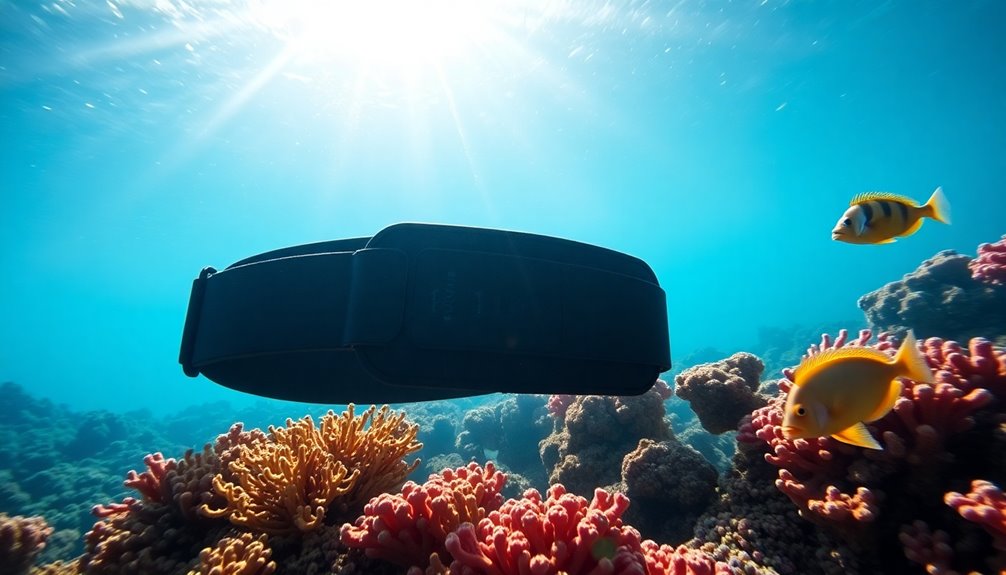
Understanding weight management is essential for every diver aiming for the perfect balance underwater. Achieving neutral buoyancy allows you to maintain a stable position without wasting energy. The weight you need can change based on several factors, including the thickness of your exposure suit, your body composition, and whether you're diving in saltwater or freshwater.
It's important to conduct regular weight checks at the end of your dives in shallow water. This practice helps you adjust your ballast for ideal buoyancy and guarantees you're not carrying unnecessary weight.
Remember, a weight loss of about 10 lbs may only require a 1-2 lb adjustment in ballast due to the different buoyancy characteristics of body fat versus muscle density.
To keep track of your weight needs and equipment specifics, document them in your dive log. This record will be invaluable for future dives, helping you make quick adjustments and enhancing your safety.
Benefits of Diving Belts
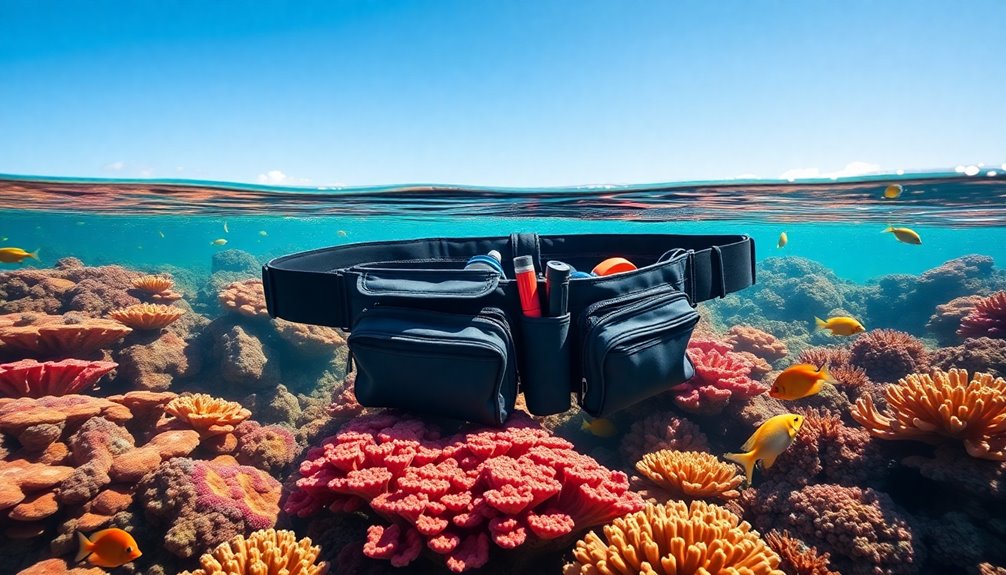
Equipped with a diving belt, you can enhance your underwater experience greatly. Diving belts offer a range of benefits that improve comfort, control, and overall enjoyment while diving. Here are some key advantages:
- Customizable Fit: Adjustable nylon scuba weight belts guarantee a secure fit for divers of all sizes, enhancing comfort during underwater activities.
- Optimal Buoyancy Control: They facilitate smooth and balanced descents, vital for enjoying your dive without unnecessary effort.
- Durable Construction: Made from high-quality materials like nylon and stainless steel, diving belts are built to withstand the rigors of underwater use while maintaining reliability.
- Streamlined Design: The minimalist design reduces drag, allowing for easier maneuverability, helping you glide effortlessly through the water.
With diving belts, you can also accommodate additional weight pockets, enabling easy adjustments based on varying dive conditions and your individual buoyancy needs.
This adaptability guarantees that you can focus on the beauty of the underwater world, rather than worrying about your gear.
Whether you're a novice or an experienced diver, investing in a quality diving belt will greatly enhance your diving experience.
Choosing the Right Weight System

When choosing a weight system, you need to take into account both the type of weights and how they fit your body.
Think about how your exposure suit's thickness and your body composition affect buoyancy.
This personalization guarantees you achieve the right balance for a safe and comfortable experience underwater.
Weight Type Considerations
Selecting the right weight system is essential for achieving ideal buoyancy during your dives. A weight belt is a classic option that allows for straightforward weight management, but your choice depends on several factors.
Consider these critical elements when selecting your weight system:
- Exposure Suit: Thicker wetsuits or drysuits often need more weight to counteract additional buoyancy.
- Body Type: Your natural buoyancy varies, impacting how much weight you'll need and where it should be placed.
- Dive Conditions: Saltwater is denser than freshwater, requiring adjustments in weight to maintain optimal balance.
- Experience Level: Beginners should consult with experienced divers or instructors for guidance on weight selection.
Personalization and Fit
Finding the right fit for your weight system is essential for enhancing your diving experience. When selecting the appropriate weight system, consider factors like exposure suit thickness, body type, and dive conditions. This guarantees ideal buoyancy control and comfort underwater.
Check out the table below to see various weight system options:
| Weight System Type | Material Options | Customization Features |
|---|---|---|
| Weight Belts | Nylon, Rubber | Different sizes, colors |
| Ankle Weights | Soft, Hard | Adjustable weight |
| Integrated Systems | Neoprene, Mesh | Size and color choices |
| Vest Systems | Polyester | Custom fit adjustments |
| D-ring Systems | Nylon, Plastic | Modular weight options |
Customizable options can enhance your fit, allowing you to choose sizes and colors that match your style while guaranteeing proper weight distribution. Additionally, incorporating ankle weights can help fine-tune your trim and balance, giving you more flexibility in achieving neutral buoyancy.
Don't hesitate to seek expert guidance to determine the best weight system tailored to your needs, promoting a safer and more enjoyable diving adventure.
Material and Durability Insights
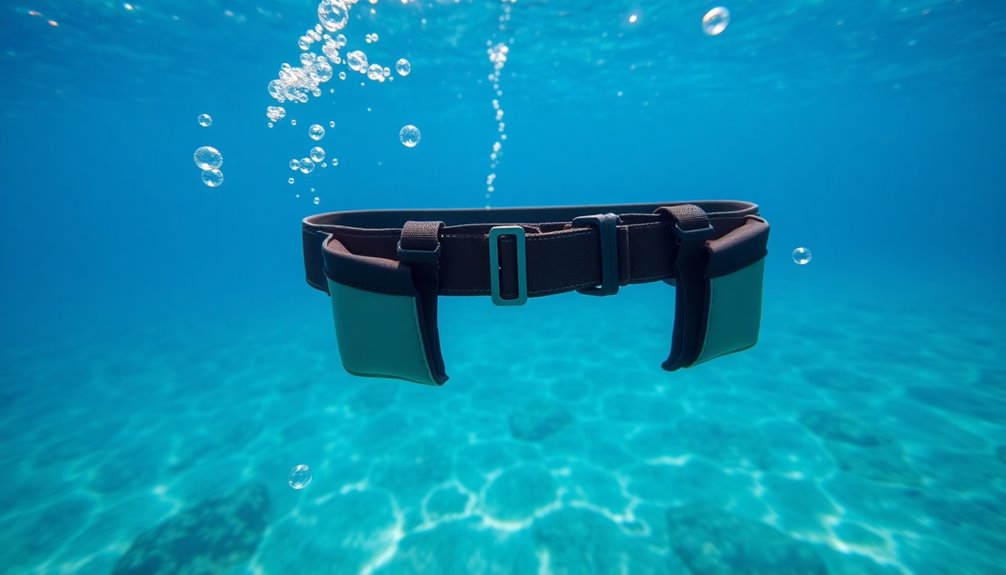
A diving belt's material plays an essential role in its performance and durability, guaranteeing it withstands the rigors of underwater exploration.
When you choose a diving belt, you want to be confident it can handle the pressure, and high-quality nylon weight is key.
Here are some features contributing to the durability of your diving belt:
- Stainless Steel Buckle: Provides a secure fit, minimizing the risk of accidental release underwater.
- 1000 Denier Cordura: Enhances strength and longevity, making it suitable for various diving conditions.
- Double Needle Stitching: Reinforces the construction, allowing for heavy use without compromising integrity.
- Resin-Coated Nylon Webbing: Prevents fraying and wear, guaranteeing the belt maintains its performance over time.
These materials and techniques not only enhance the longevity of your diving belt but also guarantee that it remains reliable dive after dive.
With the right construction, you can focus on your underwater adventure, knowing your gear's built to last.
Make sure you choose a belt that meets these high standards for a worry-free diving experience.
Expert Tips for Buoyancy Control

To master buoyancy control, you need to understand how to adjust your weights based on your exposure suit and body composition.
Regularly testing your buoyancy in a controlled setting will help you make the right adjustments for a safe experience.
Keep a log of your weight needs and gear to streamline future outings and guarantee you're always prepared.
Weight Adjustment Techniques
Effective weight adjustment techniques are essential for achieving ideal buoyancy control while immersing. By mastering these skills, you guarantee a comfortable and safe underwater experience.
Here are some expert tips to help you adjust your weight effectively:
- Conduct weight checks at the end of a dive in 10-15 feet of water, making sure your BCD is fully deflated.
- For every kg of body fat lost, reduce your weight by approximately 0.144 kg (or 0.32 lbs). Regularly monitor your body composition!
- Use a buddy's assistance during weight checks for added safety and accuracy while testing buoyancy.
- Document your weight requirements and dive gear specifics in a dive log to track necessary adjustments based on equipment changes or body weight fluctuations.
When adjusting weights, aim to change by 1-2 lbs for every 10 lbs of body weight change. This will help you maintain peak buoyancy throughout your diving experience.
Testing Buoyancy Effectively
Testing buoyancy is vital for guaranteeing you can navigate the underwater world with confidence.
Begin by conducting weight checks at the end of a plunge in 10-15 feet of water, making sure your BCD is fully deflated. This will give you a clear picture of your buoyancy. It's essential to utilize a buddy during these tests; they can assist you and help make adjustments as needed.
To check your buoyancy, take a deep breath. If you experience a slight ascent, you're on the right track. If you sink, it might be time to adjust your weights for ideal control. Remember, the right diving belt can make a significant difference in your buoyancy management.
Don't forget to document your weight needs and equipment specifics in a dive log. This practice guarantees you'll have a reliable reference for future dives, making adjustments easier over time.
Testing buoyancy in a controlled environment is key. It allows you to account for any changes in gear or body composition before entering open water, enhancing your safety and enjoyment during your underwater adventures.
Customer Experiences and Reviews
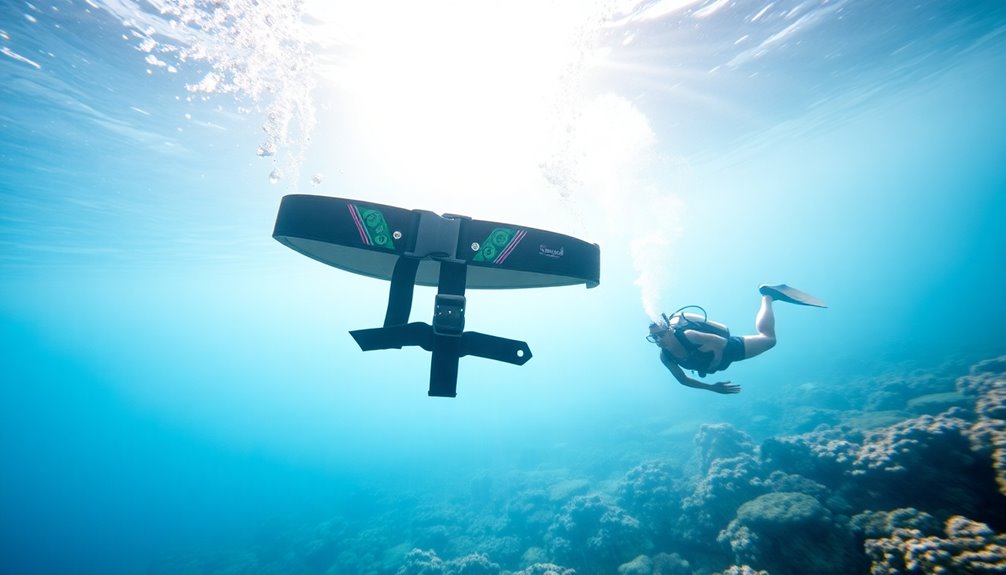
Customers have shared overwhelmingly positive experiences with the weight belt, boasting an impressive 4.8 out of 5 rating from 4,709 reviews. This high satisfaction reflects its performance and comfort, making it a favorite among divers.
Here's what users love about the weight belt:
- Adjustable Fit: The customizable design accommodates various body sizes and shapes, ensuring a snug fit.
- Durable Construction: Made from high-quality nylon and stainless steel, divers feel confident in its reliability and longevity.
- Minimalist Design: The sleek look not only complements your dive gear aesthetically but also minimizes drag for a smoother underwater experience.
- Perfect Gift: It's often recommended as a thoughtful gift for diving enthusiasts, blending style with essential functionality.
With such high ratings and glowing reviews, it's clear that the weight belt is a game-changer for divers.
Whether you're a seasoned pro or just starting, this belt could be the perfect addition to your dive gear.
Immerse yourself in your underwater adventures with confidence, knowing you've chosen a product that's backed by your fellow divers!
Frequently Asked Questions
Do Scuba Divers Still Use Weight Belts?
Yes, scuba divers still use weight belts as they're a traditional and effective way to manage buoyancy underwater.
You'll find that weight belts allow for easy adjustments based on dive conditions. Typically made from durable materials, these belts often feature quick-release buckles for safety.
Many divers combine them with other weight systems for ideal buoyancy control, ensuring a smoother descent and a more enjoyable diving experience. Additionally, elite free divers often use ankle weights to help them achieve optimal buoyancy control as they descend to great depths without the use of scuba equipment. These weights aid in keeping their bodies streamlined and stable as they navigate through the water, allowing them to conserve energy and stay underwater for longer periods of time. By incorporating ankle weights into their diving gear, both novice and experienced divers can improve their overall diving performance and maximize their enjoyment of the underwater world.
How Heavy Should My Weight Belt Be for Diving?
Wondering how heavy your weight belt should be? Start by considering your body weight, aiming for 5-10% of it.
If you're diving in a thick wetsuit or drysuit, you might need an extra 2-4 lbs.
Keep in mind your body composition—more body fat means you might float, while muscle makes you sink.
Regularly check your buoyancy in a controlled environment to guarantee you're perfectly balanced for a safe dive.
Do Free Divers Use Weight Belts?
Yes, free divers use weight belts to achieve neutral buoyancy and enhance their diving experience.
By adding weight, you can descend more effortlessly and minimize energy expenditure. The right amount of weight depends on your body composition, wetsuit thickness, and dive conditions.
Many divers prefer adjustable weight belts for quick modifications, ensuring comfort and safety. Plus, these belts often come with quick-release mechanisms, allowing for rapid ascents in emergencies.
Safety should always be your priority!
How Much Weight to Put on a Weight Belt?
To determine how much weight to put on your weight belt, start with about 10% of your body weight.
Adjust this based on your body type, exposure suit thickness, and dive conditions. If you're diving in saltwater, you'll need more weight than in freshwater.
Always conduct a weight check with a buddy in shallow water, ensuring your buoyancy compensator is fully deflated to find that sweet spot for neutral buoyancy.
Conclusion
In the world of diving, mastering weight management is like finding the right balance in life—too much or too little can lead to chaos. With the right diving belt, you can glide effortlessly beneath the waves, experiencing the freedom of the underwater domain. Remember, it's not just about the gear; it's about how you connect with your environment. So, embrace your journey and let your diving belt be your guide to a more buoyant experience, both in and out of the water.

